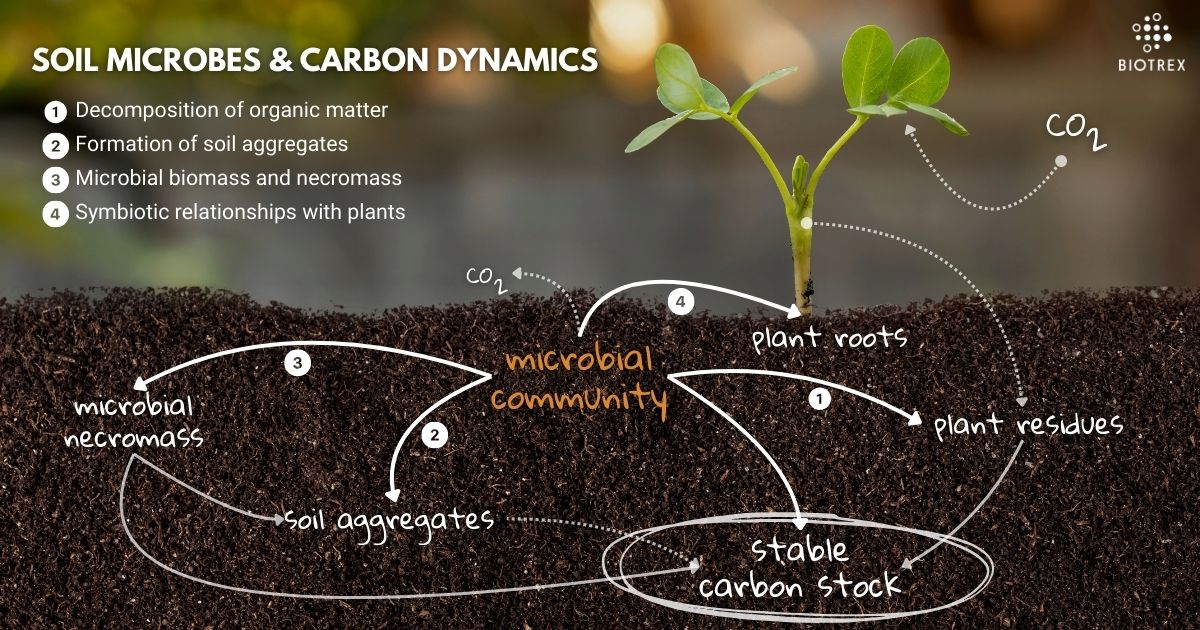Modern agriculture plays a crucial role in our world today, both as a major contributor to greenhouse gas emissions, and as a potential solution to mitigate climate change and reduce global emissions. This potential lies hidden beneath the soil surface, where atmospheric carbon is sequestered and stored. Soil is a large carbon reservoir containing between 1,100 and 1,500 gigatones of carbon in the top metre of soil, which is roughly double that of the atmosphere. As the total carbon in the earth is unchangeable, the more carbon is stored in the soil, the less carbon dioxide there is in the atmosphere. This way, the process known as carbon sequestration can help reduce the amount of carbon dioxide in the atmosphere and, as a result, help to slow down climate change.
Increasing the amount of carbon stored in the soil has benefits for both the environment and agriculture. Soil organic carbon is a part of soil organic matter, which is widely recognised as a key element for maintaining soil health and fertility. Adequate organic matter content is related with improved soil structure, increased nutrient and water retention, and high activity and diversity of soil microbes. Sadly, intensive farming, characterized by the overuse of chemical fertilizers, pesticides, and continuous tillage, has resulted in the depletion of soil organic matter. It is estimated that human activities have caused the loss of up to 78 gigatons of carbon from the world’s soils since pre-industrial times.
To address this issue, regenerative agriculture and other farming strategies have been developed. These strategies consists of practices that support the accumulation of organic matter in the soil such as cover cropping, reduced tillage, and the application of organic fertilisers and biostimulants. To monitor the efficiency of this practices, the measurement of soil organic matter content is used. However, the success of these practices heavily depends on the presence and activity of soil microbial community.
Soil microbes play crucial role in carbon cycling by influencing various processes related to soil organic matter decomposition, transformation, and stabilisation.

Soil microbes are responsible for decomposing organic matter, leading to the release of carbon dioxide into the atmosphere. However, they also transform organic matter into more stable, resistant to degradation forms, like humic acids, contributing to the long-term storage of carbon in the soil. Fate of the carbon depends on the Carbon Use Efficiency (CUE), a measure that indicates how effectively microbes convert carbon into biomass. Higher CUE means that a greater fraction of the carbon taken up by microbes is used to produce new microbial cells (biomass), and a lower fraction is lost as CO2 through respiration.
Microbes can promote soil aggregation by producing substances that act as binding agents between soil particles. Aggregated soil structures provide physical protection to organic carbon, reducing its vulnerability to decomposition and enhancing its long-term stability in the soil. In addition, microbial necromass, the dead biomass of microorganisms in the soil, can contribute to the stabilisation of soil aggregates.
Soil microbes use carbon to build their bodies and grow. When they eventually die, they become necromass. This necromass contributes to the pool of soil organic carbon and can be stabilized through physical and chemical interactions with soil minerals and organic matter.
Plants release organic compounds through their roots, known as root exudates. These exudates attract beneficial soil microbes such as mycorrhizal fungi and rhizobia bacteria. In return, these microbes enhance nutrient uptake by the plant, including nitrogen and phosphorus, which are essential for plant growth and carbon fixation. The presence of mycorrhizal fungi and other beneficial microbes in the rhizosphere (soil surrounding plant roots) increases the input of carbon-rich organic matter into the soil. These organic compounds are then decomposed by soil microbes, leading to the formation of stable forms of soil organic carbon.
Improving carbon sequestration through soil management practices requires focusing on the soil microbial community. While SOM content is a valuable measure, incorporating microbial activity provides a more comprehensive insight into soil health and its capacity for carbon sequestration. Understanding the interactions between the soil microbial community and carbon dynamics is crucial for implementing soil management practices that enhance carbon sequestration potential, benefiting both agriculture and the environment.
References:
- A.R.G. Mason, M.J. Salomon, A.J. Lowe, T.R. Cavagnaro, Microbial solutions to soil carbon sequestration, Journal of Cleaner Production, Volume 417, 2023
- Siddhartha Shankar Bhattacharyya, Gerard H. Ros, Karolina Furtak, Hafiz M.N. Iqbal, Roberto Parra-Saldívar, Soil carbon sequestration – An interplay between soil microbial community and soil organic matter dynamics, Science of The Total Environment, Volume 815, 2022

